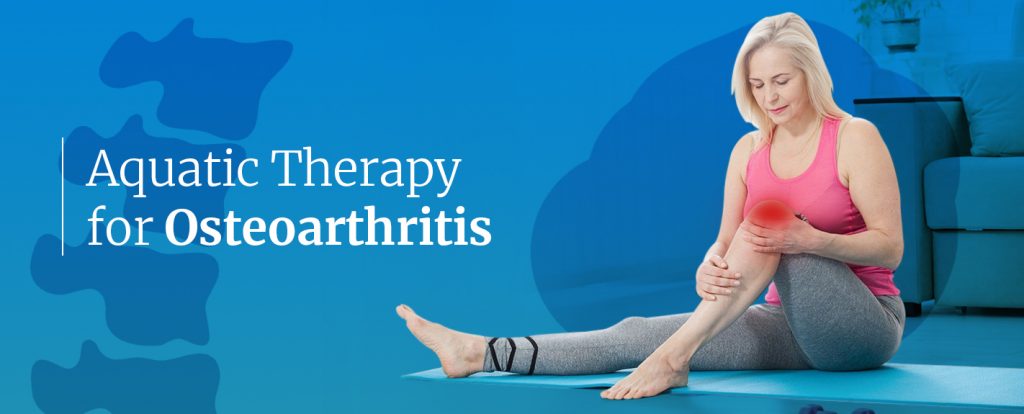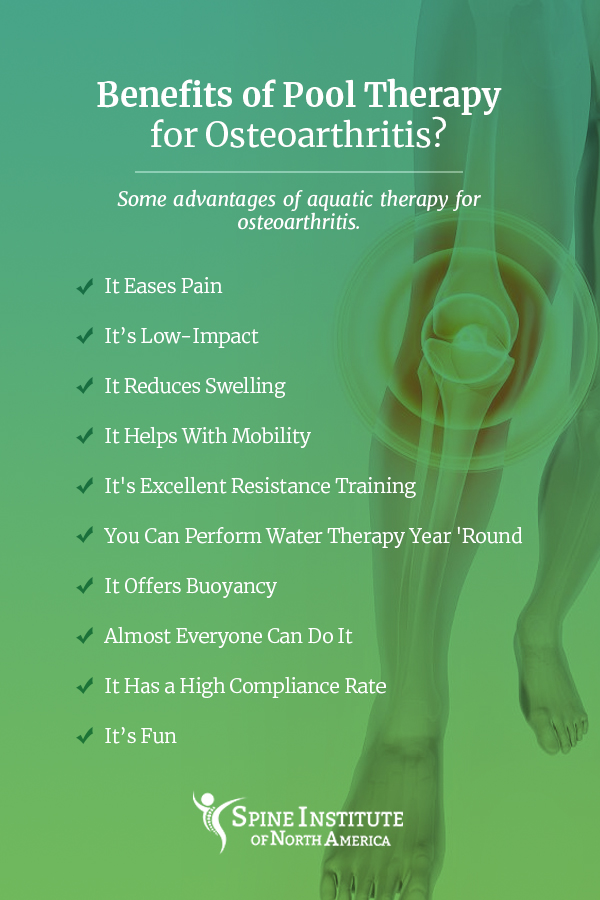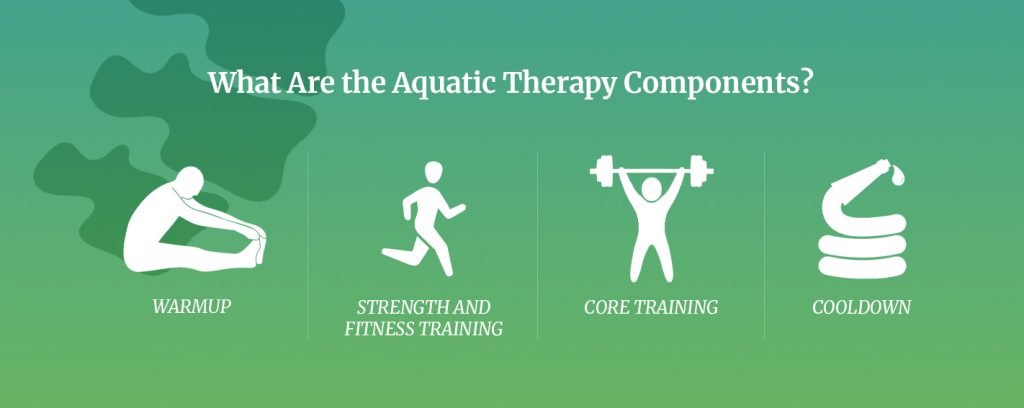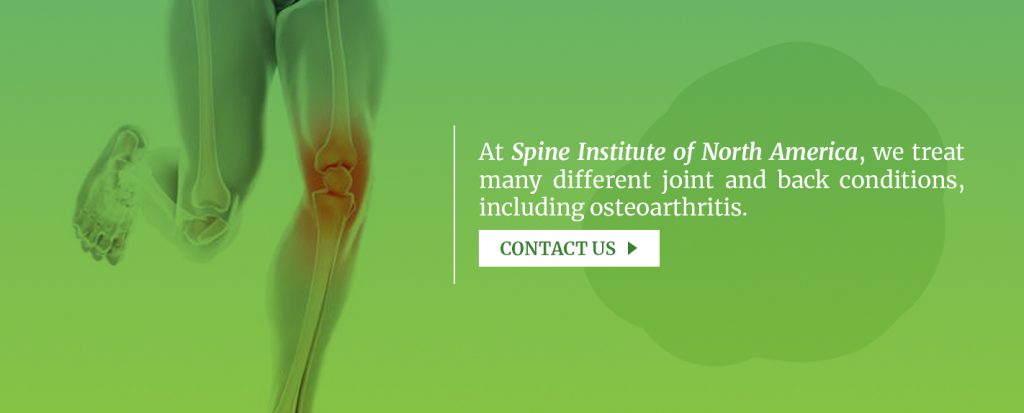This content was medically reviewed by Baher S. Yanni, MD, on June 4th, 2019.
Osteoarthritis (OA) affects around 27 million people in the United States. It’s a leading cause of disability in the elderly. OA has no cure. However, you can obtain osteoarthritis relief through methods like aquatic therapy to manage how it impacts your lifestyle.
What Is Osteoarthritis?
Osteoarthritis, sometimes called degenerative arthritis or degenerative joint disease, is the most common chronic joint condition. It can affect any joint, and it often occurs in the hips, knees, neck, lower back, the bases of the thumbs, small joints of the fingers and big toe.
Symptoms include:
- Knobby swelling at the joint
- Joint stiffness and pain
- Decreased joint function
- Grinding or cracking noise with joint movement
You have a 46% lifetime risk of developing osteoarthritis of the knee, and a 25% lifetime risk of developing it in the hip.
While any person of any age can develop OA, it’s most common in individuals older than 65. Common risk factors are obesity, increasing age, overuse of the joint, previous joint injury, genes and weak thigh muscles.
In healthy joints, a rubbery, firm material, known as cartilage, covers the end of each of your bones. Cartilage offers a gliding, smooth surface for joint movement and works like a cushion between your bones. Cartilage breaks down in osteoarthritis, causing swelling, pain and difficulties moving the joint.
As OA worsens over time, your bones could break down and develop spurs, or growths. You may have bits of cartilage or bone chip off and float around in your joint. An inflammatory process occurs in your body and enzymes and proteins called cytokines develop, further damaging your cartilage. In OA’s final stages, your cartilage wears away, and you have bone rubbing against bone, causing joint damage and pain.
What Is Aquatic Therapy for Osteoarthritis?
Aquatic therapy is a type of physical therapy you perform in an aquatic environment, usually a pool, under a trained health care professional’s supervision. Aquatic therapy also goes by the following terms:
- Aqua therapy
- Pool therapy
- Water therapy
- Hydrotherapy
- Aquatic rehabilitation
- Aquatic exercise
Exercise is an essential component of any arthritis treatment program because it helps stabilize and strengthen the joints to prevent further damage. For individuals suffering from osteoarthritis, regular exercise can bring on pain that could feel unbearable. As a type of exercise, aquatic therapy is an excellent option for those with OA of the hip, knee or those with spinal osteoarthritis due to reduced pressure put on the joints.
Health care professionals accept water therapy as part of physical therapy and exercise programs. As its name implies, participants performing it are typically submerged in a pool that’s deep enough to reach their neck or shoulders.
A pool offers an ideal environment to exercise due to its buoyancy counteracting gravity, and thereby reduces the weight you’re placing on your spine and painful joints. Reduced weight bearing is one of the numerous benefits of aquatic therapy if you have OA.
History of Water Therapy for Osteoarthritis Relief
Aquatic rehabilitation is a term describing a medical rationale, scientific therapy and a set of clinical practices that use water immersion to restore physiologic activity, physical mobility and sometimes to impact psychological transformation.
Water therapy’s long history started as cold and hot baths used for treating disease long ago, even as far back as 460 BCE.
Individuals have been using water therapy around the world for thousands of years. For instance:
- Ancient Romans and Greeks bathed in hot springs to promote relaxation and improve circulation.
- Swiss monks used thermal waters for treating disabled and sick individuals in their community.
- Hippocrates suggested springwater bathing to help treat sickness.
- German doctors strongly believed in pediatric water therapy, and water birthing was quite popular in Germany.
- Japanese onsens, or hot springs, are thought to have medicinal effects, including treating skin problems, curing menstrual disorders, relieving constipation and healing chronic pain like with osteoarthritis.
What Are the Benefits of Pool Therapy for Osteoarthritis?
When you have OA pain, you can’t always perform a lot of land-based exercises without worsening your pain. But, in a gravity-reduced, buoyant environment like water, you can often perform gentle movements to improve flexibility, strength and endurance.
Here are some advantages of aquatic therapy for osteoarthritis.
1. It Eases Pain
Everyone knows heat helps ease pain. If you are performing your exercises in a heated pool, it could offer you some pain relief — ideally, pools heated to around 82 to 88 degrees.
2. It’s Low-Impact
Exercises — like running or walking — are often painful for arthritic joints. Aquatic therapy, on the other hand, doesn’t cause this issue, due to the water’s buoyancy, which helps reduce the pressure on your joints. When you’re submerged neck-deep in water, it supports up to 90% of your body weight.
3. It Reduces Swelling
You might notice when you’re sitting in water, there’s pressure on your submerged body parts. This hydrostatic pressure offers some compression to help reduce joint swelling and inflammation.
4. It Helps With Mobility
Aquatic therapy helps improve balance, posture and range of motion. These often suffer because of the stiffness and pain linked with arthritis, but they’re all essential in maintaining mobility as you get older.
5. It’s Excellent Resistance Training
Water is 12 to 14% more resistant than air. Therefore, when you’re performing your pool exercises, it’s like you’re wearing weights around your body. Walking or performing exercises in water doesn’t require any effort, so you’ll ultimately build more muscle and burn more calories, making you stronger and leaner.
6. You Can Perform Water Therapy Year ‘Round
During the warmer weather, you can take a dip in the pool, ocean or lake outdoors and feel refreshed as you perform your aquatic therapy. And, even when the temperatures become cooler, you can still perform your pool therapy indoors in a heated, indoor pool.
7. It Offers Buoyancy
Buoyancy benefits people in many ways, including:
- Weight-bearing qualities
- Reduced joint compression forces
- Stress on connective tissues
Buoyancy also enhances range of motion and flexibility and supports weak muscles. It strengthens muscles working against buoyancy and changes biomechanical stress. It makes it easier for therapists to hold and support their patients in the water.
8. Almost Everyone Can Do It
Regardless of your level of expertise in swimming, you can still benefit from aquatic therapy. Any person can participate, even if you can’t swim. When you perform aquatic therapy in deep water, you’ll use flotation devices that help you stay buoyant, leaving you to concentrate on your movements instead of trying to keep your head above water.
9. It Has a High Compliance Rate
Aquatic therapy leads to a higher compliance rate, compared to other types of physical therapy, because there is less pain during the recovery process. When there’s less pain, it’s easier to perform the exercises, and there are more chances of patients doing them.
10. It’s Fun
Many people find exercising in the pool fun, as it is a unique and engaging environment.
Types of Aquatic Therapy Exercises
Pool therapy helps improve balance, agility and cardiovascular fitness. Various conditions benefit greatly from aquatic therapy exercises, including osteoarthritis. But, before you begin any water exercise program, talk with your doctor or physical therapist first to ensure the movements you’re going to perform are right for you.
Many motions that are part of aqua therapy for osteoarthritis patients appear similar to resistance or stretching exercises you do on land, except they use gentle water resistance instead of gravity to exercise joints or muscles. Some popular water exercises are:
1. Strengthening
These activities include the use of foam barbells for completing lateral side raises or bicep curls that work against the resistance of the water.
2. Stretching
These motions include stretching the lower back and hamstrings by slowly raising your knees to your chest or stretching your neck or upper back by standing away from the poolside and leaning forward with outstretched arms to grasp the edge of the pool.
3. Ai Chi
This program is a hybrid type of tai chi designed specifically for water exercise to develop balance, strength and joint flexibility through gentle, slow motions while focusing on controlled breathing and relaxation.
4. Water Aerobics
Cross-country skiing motions, walking or slow jogging around a shallow pool are examples of water aerobics that loosen your hips and lower back.
5. Aqua Running
Also referred to as aqua jogging or deep-water running, this exercise involves running in the water, where you use a flotation belt for supporting your upper body and head above water while you preserve normal biomechanics. Aqua running allows you to experience the advantages of carrying out rehabilitation protocols without affecting your joints.
6. Bad Ragaz Ring Method
This exercise provides mobilizing resistive and water-based strengthening. The “ring” part of this water therapy’s name refers to a circular flotation device used for supporting your head as you move across the surface of the water. During each session, you lie supine in shoulder- or waist-deep water.
Individuals suffering from soft tissue injuries, rheumatoid arthritis, head injuries or spinal injuries often use this exercise.
7. Halliwick
The Halliwick aquatic therapy technique focuses on helping you develop core stability and balance. It includes:
- Sagittal rotation control
- Mental adjustment
- Mental or upthrust inversion
- Transversal rotational control
- Balance in stillness
- Combined rotation control
- Longitudinal rotation control
- Basic Halliwick movement
- Simple progression
- Turbulent gliding
The Halliwick water therapy is a problem-solving technique. Therapists work to assess your specific abilities and limitations before they develop interventions leading to maximum functional increases.
8. Watsu
Watsu helps treat a large range of neurological and orthopedic problems, either as a complement to land-based programs or a standalone therapy. It’s also inspired other types of aquatic therapy, including the following.
- Waterdance: A type of hydrotherapy that uses rolls, massage, dance, inversions, Aikido-like moves and somersaults. You start each session with stretches above water and progress to using a nose plug and exercising underwater.
- Healing dance: Combines components of Waterdance and Watsu. It focuses on rhythm, flow and 3D motions under and above water.
- Jahara technique: A peaceful type of aqua therapy that incorporates flotation devices for providing continual traction while stressing muscular release, spinal alignment and gentle bodywork.
What Are the Aquatic Therapy Components?
When you’re using aqua therapy to promote physical fitness, you break up each session into four parts.
- Warmup: You begin with low-resistance exercise made for targeting your lower and upper extremities. Often, this includes extensions and stretches, followed by brief jogging or walking on an underwater treadmill.
- Strength and fitness training: After your warmup, you’ll usually perform cardiovascular activities like multi-planar activities, sprint intervals or running. You can also perform plyometrics and other strength activities.
- Core training: After strength and fitness training, you do around 20 to 30 minutes of leg swings, squats, shoulder presses, arm swings and other core-training exercises.
- Cooldown: You’ll use a therapy pool that has a massage hose connected to resistance jets for a deep tissue massage to work your muscles, so you don’t have any lactic acid buildup.
Tips for Getting Started With Water Therapy for Osteoarthritis Relief
Before starting any aquatic therapy program, always check with your doctor or physical therapists to ensure water exercises are a good fit for you and your situation. Some tips to help you get started include:
- Get in chest- or waist-high water.
- Wear water shoes to help give you traction on the floor of the pool.
- Using slower motions in the water provides less resistance than quicker ones.
- Use a flotation vest/belt or Styrofoam noodle to help keep you afloat in deep water. Use of flotation equipment like barbells, belts or boards will give you added stability and resistance.
- Using Styrofoam weights, webbed water gloves, kickboards or inflated balls helps increase resistance.
- Drink plenty of water, even though you won’t notice you sweat with water exercises.
- Avoid pushing through severe pain while exercising.
What to Look for in an Aquatic Therapy Program
The approach to aquatic therapy instruction of each facility might differ a little depending on what the class is focusing on, but you should look for the following things:
- A well-lit, clean pool that’s not hot, but comfortably warm, typically between 90 and 94 degrees Fahrenheit. You can use cooler pools safely too, but they won’t be as comfortable as warmer water.
- A set of exercises which work different joints and areas of your body, from your neck through your back and down to your feet.
- A knowledgeable instructor who can explain and demonstrate the exercises.
- An instructor who tells you about their approach and objectives and allows you to observe a session.
Contact Metropolitan Pain & Spine Institute for an Osteoarthritis Evaluation
To receive an osteoarthritis evaluation, contact Metropolitan Pain & Spine Institute. At Metropolitan Pain & Spine Institute, we treat many different joint and back conditions, including osteoarthritis. We feel your pain, and we’re here to help ease your discomfort and suffering.
This content was medically reviewed by Baher Yanni, M.D, on June 4th, 2019.
Sources:
https://www.brainline.org/article/why-aquatic-therapy
https://www.arthritis-health.com/treatment/exercise/water-therapy-osteoarthritis
https://fitness.mercola.com/sites/fitness/archive/2016/02/19/benefits-water-exercises.aspx
https://www.arthritis.org/about-arthritis/types/osteoarthritis/what-is-osteoarthritis.php
https://www.rheumatology.org/I-Am-A/Patient-Caregiver/Diseases-Conditions/Osteoarthritis
https://www.arthritis.org/living-with-arthritis/pain-management/tips/warm-water-therapy.php
https://www.spine-health.com/wellness/exercise/pool-therapy-relieve-osteoarthritis-pain
https://www.spine-health.com/wellness/exercise/getting-started-pool-therapy
https://www.arthritis-health.com/treatment/exercise/water-therapy-osteoarthritis













